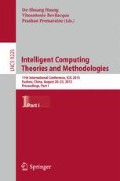Abstract
The online learning algorithm is shown to be more appropriate and effective for the processing of spatiotemporal information, but very little researches have been achieved in developing online learning approaches for spiking neural networks. This paper presents an online supervised learning algorithm based on nonlinear spike train kernels to process the spatiotemporal information, which is more biological interpretability. The main idea adopts online learning algorithm and selects a suitable kernel function. At first, the Laplacian kernel function is selected, however, in some ways, the spike trains expressed by the simple kernel function are linear in the postsynaptic neuron. Then this paper uses nonlinear functions to transform the spike train model and presents the detail experimental analysis. The proposed learning algorithm is evaluated by the learning of spike trains, and the experimental results show that the online nonlinear spike train kernels own a super-duper learning effect.
Access this chapter
Tax calculation will be finalised at checkout
Purchases are for personal use only
References
Yegnanarayana, B.: Artificial Neural Networks. PHI Learning Pvt Ltd., New Delhi (2009)
Ahmed, F.Y.H., Yusob, B., Hamed, H.N.A.: Computing with spiking neuron networks a review. Int. J. Adv. Soft Comput. Its Appl.s 6(1), 1–21 (2014)
Yu, Q., Goh, S.K., Tang, H., Tan, K.C.: Application of precise-spike-driven rule in spiking neural networks for optical character recognition. In: Handa, H., Ishibuchi, K.-C., Ong, H., Tan, K.-C. (eds.) Proceedings of the 18th Asia Pacific Symposium on Intelligent and Evolutionary Systems, vol. 2, pp. 65–75. Springer International Publishing, NewYork (2015)
Carlson, K.D., Nageswaran, J.M., Dutt, N., Krichmar, J.L.: An efficient automated parameter tuning framework for spiking neural networks. Front. Neuroscience 8, 10 (2014)
Bohte, S.M., Kok, J.N., La Poutre, H.: Error-backpropagation in temporally encoded networks of spiking neurons. Neurocomputing 48(1), 17–37 (2002)
Xin, J., Embrechts, M.J.: Supervised learning with spiking neural networks. In: Proceedings of International Joint Conference on Neural Networks, IJCNN 2001, vol. 3, pp. 1772–1777. IEEE (2001)
Schrauwen, B., Van Campenhout, J.: Extending spikeprop. In: Proceedings of 2004 IEEE International Joint Conference on Neural Networks, vol. 1. IEEE (2004)
McKennoch, S., Liu, D., Bushnell, L.G.: Fast modifications of the spikeprop algorithm. In: International Joint Conference on Neural Networks, IJCNN 2006, pp. 3970–3977. IEEE (2006)
Booij, O., Nguyen, T.H.: A gradient descent rule for spiking neurons emitting multiple spikes. Inf. Process. Lett. 95(6), 552–558 (2005)
Ghosh-Dastidar, S., Adeli, H.: A new supervised learning algorithm for multiple spiking neural networks with application in epilepsy and seizure detection. Neural Netw. 22(10), 1419–1431 (2009)
Xu, Y., Zeng, X., Han, L., Yang, J.: A supervised multi-spike learning algorithm based on gradient descent for spiking neural networks. Neural Networks 43, 99–113 (2013)
Hebb, D.O.: The Organization of Behavior: a Neuropsychological Theory. Psychology Press, New York (2005)
Caporale, N., Dan, Y.: Spike timing-dependent plasticity: a Hebbian learning rule. Annu. Rev. Neurosci. 31, 25–46 (2008)
Ponulak, F., Kasinski, A.: Supervised learning in spiking neural networks with ReSuMe: sequence learning, classification, and spike shifting. Neural Comput. 22(2), 467–510 (2010)
Florian, R.V.: The chronotron: a neuron that learns to fire temporally precise spike patterns. PLoS ONE 7(8), e40233 (2012)
Mohemmed, A., Schliebs, S., Matsuda, S., Kasabov, N.: Span: spike pattern association neuron for learning spatio-temporal spike patterns. Int. J. Neural Syst. 22(04), 1250012 (2012)
Mohemmed, A., Schliebs, S., Matsuda, S., Kasabov, N.: Training spiking neural networks to associate spatio-temporal input–output spike patterns. Neurocomputing 107, 3–10 (2013)
Yu, Q., Tang, H., Tan, K.C., Li, H.: Precise-spike-driven synaptic plasticity: learning hetero-association of spatiotemporal spike patterns. PLoS ONE 8(11), e78318 (2013)
Wang, J., Belatreche, A., Maguire, L., McGinnity, M.: Online versus offline learning for spiking neural networks: a review and new strategies. In: 2010 IEEE 9th International Conference Cybernetic Intelligent Systems (CIS), pp. 1–6. IEEE (2010)
Kasabov, N.K.: Neucube: A spiking neural network architecture for mapping, learning and understanding of spatio-temporal brain data. Neural Netw. 52, 62–76 (2014)
Oniz, Y., Kaynak, O.: Variable-structure-systems based approach for online learning of spiking neural networks and its experimental evaluation. J. Franklin Inst. 351(6), 3269–3285 (2014)
Acknowledgement
The work is supported by the National Natural Science Foundation of China under Grants No. 61165002 and No. 61363059.
Author information
Authors and Affiliations
Corresponding author
Editor information
Editors and Affiliations
Rights and permissions
Copyright information
© 2015 Springer International Publishing Switzerland
About this paper
Cite this paper
Lin, X., Zhang, N., Wang, X. (2015). An Online Supervised Learning Algorithm Based on Nonlinear Spike Train Kernels. In: Huang, DS., Bevilacqua, V., Premaratne, P. (eds) Intelligent Computing Theories and Methodologies. ICIC 2015. Lecture Notes in Computer Science(), vol 9225. Springer, Cham. https://doi.org/10.1007/978-3-319-22180-9_11
Download citation
DOI: https://doi.org/10.1007/978-3-319-22180-9_11
Published:
Publisher Name: Springer, Cham
Print ISBN: 978-3-319-22179-3
Online ISBN: 978-3-319-22180-9
eBook Packages: Computer ScienceComputer Science (R0)

